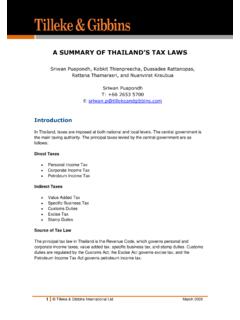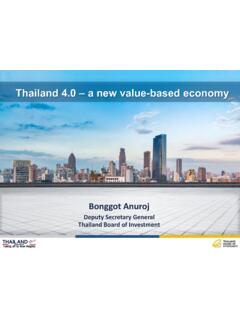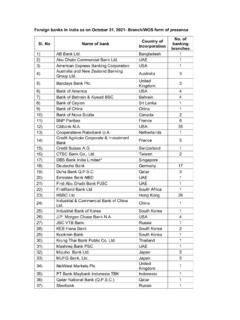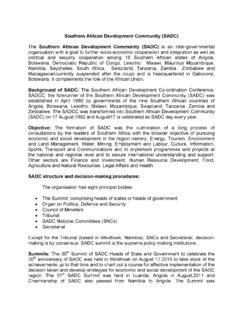Transcription of Investment Law Standard in International Fair and ...
1 Please cite this paper as:OECD (2004), Fair and Equitable Treatment Standard inInternational Investment Law , OECD Working Papers onInternational Investment , 2004/03, OECD Working Papers on InternationalInvestment 2004/03 Fair and Equitable TreatmentStandard in InternationalInvestment LawOECD DIRECTORATE FOR FINANCIAL AND ENTERPRISE AFFAIRS WORKING PAPERS ON International Investment Number 2004/3 FAIR AND EQUITABLE TREATMENT Standard IN International Investment LAW September 2004 This document, derestricted under the OECD Secretary General s responsibility, has been developed as an input to the Investment Committee s work aimed at enhancing understanding of the fair and equitable treatment Standard in International Investment law. This document benefited from discussions and a variety of perspectives in the Committee. The document as a factual survey, however, does not necessarily reflect the views of the OECD or those of its Member governments.
2 It cannot be construed as prejudging ongoing or future negotiations or disputes pertaining to International Investment agreements. This document was prepared by Catherine Yannaca-Small, Legal Advisor, Investment Division, Directorate for Financial and Enterprise Affairs. Organisation for Economic Co-operation and Development 2004 2 FAIR AND EQUITABLE TREATMENT Standard IN International Investment LAW Introduction The obligation to provide fair and equitable treatment is often stated, together with other standards, as part of the protection due to foreign direct Investment by host countries. It is an absolute , non-contingent Standard of treatment, a Standard that states the treatment to be accorded in terms whose exact meaning has to be determined, by reference to specific circumstances of application, as opposed to the relative standards embodied in national treatment and most favoured nation principles which define the required treatment by reference to the treatment accorded to other investment1.
3 Although some references to the Standard can be found in the first negotiating attempts of multilateral trade and Investment instruments, it became established as a principle mainly through the increasing network of bilateral Investment treaties. The obligation of the parties to Investment agreements to provide to each other s investments fair and equitable treatment 2 has been given various interpretations by governmental officials, arbitrators and scholars. Discussion of this Standard has focused mainly on whether the Standard of treatment required is measured against the customary International law minimum Standard , a broader International law Standard including other sources such as Investment protection obligations generally found in treaties and general principles or whether the Standard is an autonomous self-contained concept in treaties which do not explicitly link it to International law.
4 The implications of this discussion could be very broad, in particular given the growing number of arbitral awards which examine claims of denial of fair and equitable treatment. The meaning of the fair and equitable treatment Standard may not necessarily be the same in all the treaties in which it appears. The proper interpretation may be influenced by the specific wording of a particular treaty, its context, negotiating history or other indications of the parties intent. The attempts to clarify the normative content of the Standard itself have, until recently, been relatively few. There is a view that the vagueness of the phrase is intentional to give arbitrators the possibility to articulate the range of principles necessary to achieve the treaty s purpose in particular disputes. However, a number of governments seem to be concerned that, the less guidance is provided for 1 See UNCTAD, Bilateral Investment Treaties in the Mid 1990s, 1998.
5 Also see A. A. Fatouros, Government Guarantees to Foreign Investors , Columbia University Press (1962), pp. 135-141, 214-215. 2 Investment treaties vary in their precise drafting. Some expressly define the Standard by reference to International law: treaties concluded by France, US, Canada ; others do not make reference to International law, for instance treaties concluded by the Netherlands, Sweden, Switzerland and Germany. For example, The German model BIT states: Each Contracting in any case accord such investments fair and equitable treatment and the Swiss model BIT states: Investments and returns of investors of each Contracting Party shall at all times be accorded fair and equitable See UNCTAD op. cit. 3 arbitrators, the more discretion is involved and the closer the process resembles decisions ex aequo et bono, based on the arbitrators notions of fairness and equity.
6 The OECD has on two occasions in the past referred to the fair and equitable treatment Standard by linking it to the minimum Standard required by International law3 and general principles of International law4 without however comprehensively analysing its specific content5. Since then, a growing case law has been developed, which could shed light on the normative content of the Standard . The present survey provides factual elements of information on jurisprudence, literature and state practice related to the fair and equitable treatment Standard . It examines the origins of the Standard and its use in International agreements and state practice (Part I), its relationship with the minimum Standard of International customary law (Part II) and the elements of its normative content as identified by arbitral tribunals (Part III). I. The origins of the fair and equitable treatment Standard and its current use in International agreements and state practice A.
7 The origins of the Standard The first reference to equitable treatment is found in the 1948 Havana Charter for an International Trade Organisation. Its Article 11(2) contemplated that foreign investments should be assured just and equitable treatment . The Article provided that the International Trade Organisation (ITO) could: 1. make recommendations for and promote bilateral or multilateral agreements on measures 2. to assure just and equitable treatment for the enterprise, skills, capital, arts and technology brought from one Member country to another. The organisation was to be authorised, inter alia, to promote arrangements which would facilitate an equitable distribution of skills, arts, technology, materials and equipment, with due regard to the needs of all member States. Also, the member States were to recognise the right of each State to determine the terms of admission of foreign investors on its territory, to give effect to just terms on ownership of Investment , and to apply other reasonable requirements with respect to existing and future Because of a number of unresolved issues, some major developed countries did not ratify the Charter, bringing the first post-war multilateral effort on trade and Investment to an unsuccessful conclusion.
8 3 Draft Convention on the Protection of Foreign Property and Resolution of the Council of the OECD on the Draft Convention , OECD, , 1967. 4 Intergovernmental Agreements Relating to Investment in Developing Countries OECD, 1984. 5 In 1967 and 1984, the OECD countries based their work essentially on state practice and literature. 6. Although this provision is valuable as precedent, it did not itself guarantee this Standard of treatment for investors; it merely authorised the International Trade Organisation to recommend that this Standard be included in future agreements. 4 At the regional level, in 1948, the Ninth International Conference of American States adopted the Economic Agreement of Bogot ,7 an agreement covering among other things, the provision of adequate safeguards for foreign investors. Article 22 of the agreement included the following language: Foreign capital shall receive equitable treatment.
9 The States therefore agree not to take unjustified, unreasonable or discriminatory measures that would impair the legally acquired rights or interests of nationals of other countries in the enterprises, capital, skills, arts or technology they have supplied .8 Like the Havana Charter, the Bogot Agreement failed to come into force due to lack of support. At the bilateral level, the US treaties on Friendship, Commerce and Navigation (FCN), developed after the First World War, contained a Standard reference to International law in connection with protection of the persons and property of aliens. In the period following the preparation of the Havana Charter, the terms equitable and fair and equitable treatment started to appear in certain of the US FCN treaties9. The proponents of the Standard considered it as a safeguard against state action that violated internationally accepted In 1959, the Draft Convention on Investments Abroad, developed under the leadership of Herman Abs, the Director-General of the Deutsche Bank and Lord Shawcross, the UK Attorney General, in its Article 1 stipulated that each Party shall at all times ensure fair and equitable treatment to the property of the nationals of the other Parties.
10 11 This effort led to the German proposal to the OECD that it develop a convention on the International protection of private property. Intensive discussions started in the OECD in the early 60 s and culminated in the adoption of the Draft Convention on the Protection of Foreign Property by the OECD Council on 12 October Under the Article 1 (a) Treatment of Foreign Property: Each Party shall at all times ensure fair and equitable treatment to the property of the nationals of the other . The Draft Convention, although never opened for signature, represented the collective view and dominant trend of OECD countries on Investment issues and influenced the pattern of deliberations on foreign 7. See Stephen Vasciannie in The Fair and Equitable Treatment Standard in International Investment Law and Practice in the British Yearbook of International Law, (2000), vol.


















